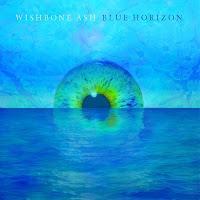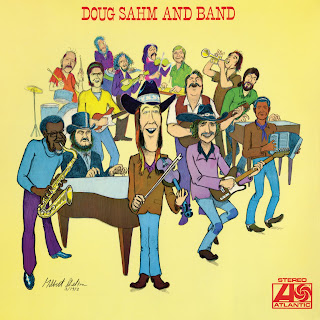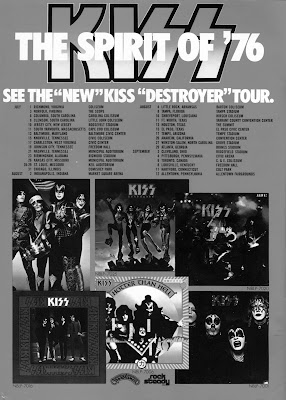Formed in 1969 by guitarist Andy Powell, bassist Martin Turner, guitarist Ted Turner, and drummer Steve Upton, Wishbone Ash sounded nearly fully-formed from day one, the band’s mix of hard rock, progressive, and folk-rock finding an appreciative audience that largely remains with them to this day. The band released its self-titled debut in 1970, and hit its creative peak early with their third album, the 1972 classic Argus. Wishbone Ash was, arguably, the first band to popularize the twin lead guitar sound later utilized by Thin Lizzy and Iron Maiden, and the band’s use of two lead singers – Powell and Martin Turner – created a unique and effective sound that added to the band’s onstage dynamic.
Andy Powell’s Eyes Wide Open
The band’s sole remaining member from the founding foursome, Andy Powell has kept Wishbone Ash going strong deep into the new millennium. Some forty-five years after their debut, the band is still releasing creative, entertaining music (check out 2014’s wonderful Blue Horizon album) with Powell at the helm of a rotating cast of musicians. Band members have come and gone through the decades – the original line-up lasted almost four years before Ted Turner departed, replaced by guitarist Laurie Wisefield – and throughout the fallow years of the ‘80s and beyond, Powell has continued to tour and record as Wishbone Ash, enlisting new fans and creating an unshakeable legacy for the band.
Powell has taken time out from a steady tour schedule to pen his version of the rock ‘n’ roll memoir, joining contemporaries like Keith Richards, Pete Townsend, and Bob Dylan in framing his career on his own literary terms. Powell isn’t the first Wishbone Ash founder to push his bio; disgruntled former member Martin Turner published his No Easy Road book back in 2012. As the last man standing, however, Powell has insight and experience provided by decades in the trenches, and as he’s struggled to keep the band rolling throughout the inevitable ups ‘n’ downs of the music biz, Powell has earned the right to offer his own spin on the band’s history.
True Tales of a Wishbone Ash Warrior
Powell’s Eyes Wide Open is an entertaining tome, the writer describing his childhood fascination with music, the making of his first guitar, and playing in his first bands, which provided him with the confidence and stagecraft to forge a career in rock ‘n’ roll. It’s with the formation of Wishbone Ash that the story takes off, though, and Powell goes into depth in talking about the band’s early years, the camaraderie between the members, and the creation of the band’s classic early albums like Pilgrimage, Argus, and Wishbone Four. This isn’t a ‘tell all’ styled bio, though, so while Powell alludes to, and sometimes writes explicitly the band’s extracurricular activities, he seldom goes into all the sordid details. Powell is quite frank about both the successes and the problems the band had with original manager Miles Copeland and the internal tensions that led to, first, Ted Turner’s departure and, later, that of Martin Turner, which opened the revolving door of band members.
Even more interesting are Powell’s memories of those years of struggle during the 1980s and ‘90s, his assumption of the mantle of band leadership through attrition, and the fight to continue creating credible new music (with the sonic experimentation that included) with an ever-changing line-up of talented musicians. The band’s modest success during these later years has only happened via the support of a loyal, worldwide fan base that has allowed Wishbone Ash to continue touring and recording to the present day. Powell acknowledges a large number of the band’s fans and their contributions in the book, also pointing out a few of the more detrimental hangers-on, haters who have attempted to derail Powell’s ongoing efforts, either due to jealousy or simple malevolence.
Blue Horizon
One of the biggest ‘haters’ of the Wishbone Ash legacy is former member Martin Turner, whose obviously bruised, but enormous ego won’t allow him to bury the past and move on. Powell goes into detail about the legal battle between he and Turner that eventually arose over the use of the Wishbone Ash name (the former bass player and singer began touring as Martin Turner’s Wishbone Ash in 2004 without Powell’s consent), a fight that Powell won. True, Eyes Wide Open provides Powell’s perspective on the issues between himself and his former bandmate, but considering that Turner never developed a significant solo career and, to this day, considers himself as the “key creative force” behind Wishbone Ash while using the band’s name to sell his music, you’ll forgive me if I lean towards Powell’s version of the story as the band’s longtime captain and surviving member.
Powell’s frequent ‘detours’ from his story are welcome, including a chapter on his long-suffering partner of 45+ years, wife Pauline, Powell’s school sweetheart who has stoically kept the home fires burning while the musician was off making money. His chapter on India is simply fascinating, Powell displaying a keen eye and a real talent in talking about touring the country and observing the economic chasm that exists between its poorest and richest citizens. A detour into talking about guitars is also a lot of fun for any gear fanatic, as the guitarist known for his Flying V talks about the various axes he’s had and played through the years. The obligatory chapter on touring (“Road Works”) should be required reading for every young musician, as Powell describes in depth the many obstacles and hazards of the road warrior.
The Reverend’s Bottom Line
One doesn’t have to be a Wishbone Ash fan to enjoy Andy Powell’s Eyes Wide Open. Sure, classic rock fans will find a lot to like in Powell’s stories about rock ‘n’ roll during the 1970s, but equally of interest are his efforts in dealing with the changes in the industry through the years, his attempts in keeping the band relevant in this age of instant (and fast-fading celebrity) and, most importantly, the process behind making vital new music like 2011’s Elegant Stealth and the aforementioned Blue Horizon album.
Eyes Wide Open includes an extensive Wishbone Ash discography compiled by music journalist Colin Harper, including an accounting of all the band’s BBC sessions and their studio and live albums (almost three dozen recordings to date), as well as an exhaustive list of the band’s live dates from 1971 through 2015, all of which will certainly appeal to the Wishbone Ash fanatic. For the rest of us, the book defines a legacy of great music, the product of an unheralded rock ‘n’ roll genius that continues to chase the brass ring almost five decades down the road. Grade: A (Jawbone Press, published November 9, 2015)
Buy the book from Amazon.com: Andy Powell's Eyes Wide Open

























